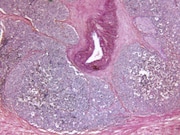Lesion-targeted plus systematic sampling appears to maximize the accuracy of first-time prostate biopsy
WEDNESDAY, June 26, 2019 (HealthDay News) — A lesion visible on magnetic resonance imaging (MRI) identifies a heightened risk for clinically significant prostate cancer in men undergoing first-time prostate biopsy, and a combination of targeted and systematic biopsy may improve the chances of detecting cancer, according to a study published online June 12 in JAMA Surgery.
Fuad F. Elkhoury, M.D., from the University of California, Los Angeles, and colleagues used data from men undergoing first-time prostate biopsy as part of the Prospective Assessment of Image Registration in the Diagnosis of Prostate Cancer cohort study (January 2015 to April 2018). Two hundred forty-eight men with MRI-visible lesions each underwent three biopsy methods at the same sitting: a systematic biopsy, an MRI-lesion biopsy targeted by cognitive fusion, and an MRI-lesion biopsy targeted by software fusion. Another series of 52 men without MRI-visible lesions underwent systematic biopsies to help determine the false-negative rate of MRI during the trial.
The researchers found that the overall cancer detection rate (CDR) was 70 percent in the paired-cohort group when systematic and targeted biopsy results were combined. With systematic sampling, the CDR was 15 percent in the group without MRI-visible lesions. In the paired-cohort group, CDRs ranged from 47 percent (116 of 248 men) with cognitive fusion biopsy alone and 60 percent with systematic biopsy (149 of 248 men) or either fusion method alone (154 of 248 men) to 70 percent (174 of 248 men) with combined systematic and targeted biopsy. The Prostate Imaging Reporting & Data System version 2 grade and prostate-specific antigen density were directly associated with CDRs for all biopsy methods, while prostate volume was inversely associated.
“Discordance of tumor locations suggests that the different biopsy methods detect different tumors,” the authors write. “Thus, combining targeting and systematic sampling provide greatest sensitivity for detection of clinically significant prostate cancer.”
Two authors disclosed ties to medical technology company Avenda Health Inc.
Abstract/Full Text (subscription or payment may be required)
Copyright © 2019 HealthDay. All rights reserved.








